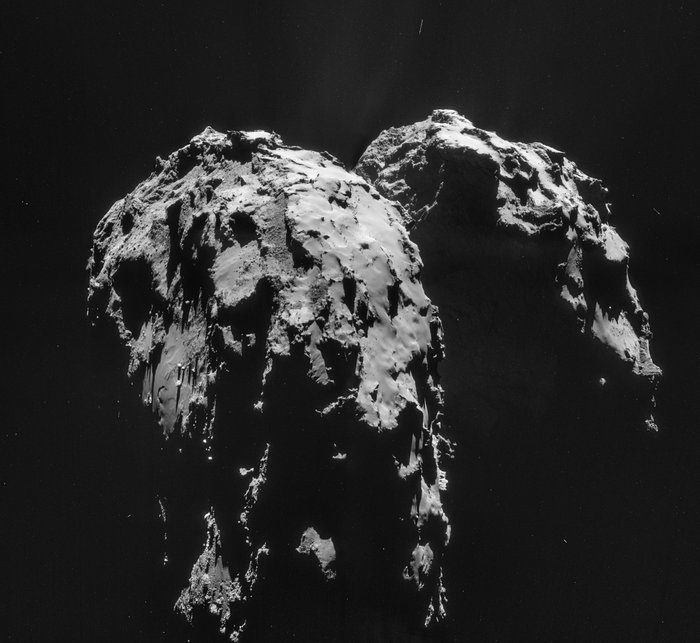
There was no shortage of drama when the European Space Agency’s probe Philae set down on a comet last month—the first such landing in history. First Philae bounced, then it bounced again, ending up with one of its three legs sticking up in the air, and in the shadow of a cliff that prevented its solar panels from recharging its batteries. For two days, the probe hurried to complete whatever science it could….and then everything went black.
But that hardly spelled the end of the mission. Philae’s mother ship, Rosetta, has continued to orbit comet 67P/Churyumov–Gerasimenko, as it’s been doing since August, taking measurements and images of unprecedented quality. And with nearly a year of close-up observations to go, Rosetta has already come up with one result, described in a new paper in Science, that chief scientist Matt Taylor, of the European Space Agency, labeled “fantastic”: Earth’s oceans, the scientists have concluded, were evidently not created by impacts from comets rich with water ice, despite earlier evidence to the contrary. “We have to conclude instead,” said lead author Kathrin Altwegg, a planetary scientist at the University of Bern, at a press conference, “that the water came from asteroids.”
That’s a big reversal from what scientists were thinking just a few years ago. Back in 2011, the European Herschel space telescope took a hard look at Comet Hartley 2 and determined that its own cache of water, detected as vapor boiling away as Hartley approached the Sun, had a chemical composition very similar to what we see on Earth. It’s all H2O, but some of the H is a rare form of hydrogen known as deuterium, whose atoms carry not just a proton like the ordinary stuff, but a neutron as well. Water molecules made with deuterium are known as “heavy water,” and about three in a thousand water molecules on Earth’s surface are the heavy kind.
Measurements of Halley’s Comet back in the mid-80’s showed a deuterium-to-hydrogen ratio about twice that high, which argued against the idea that comets delivered water to a bone-dry Earth early in the Solar System’s history. But Halley’s came from the Oort Cloud, a spherical swarm of proto-comets orbiting at the far edges of the Solar System. Hartley 2 came from the Kuiper Belt of comets, which lies just beyond Neptune–not exactly nearby, but a whole lot closer. Given what Herschel found at Hartley 2, it appeared that Kuiper belt comets are chemically different from those that hail from the Oort cloud. If so, our water could have cometary origins after all.
The new results from Rosetta say no: Comet 67P, which also comes from the Kuiper belt, has an even greater proportion of heavy water than Halley’s and other Oort cloud objects. Even if significant numbers of comets do have Earthlike water, some clearly don’t—and even a relative few would have made Earth’s proportion of heavy water higher than it is. It’s arguable that 67P is pretty much unique among its Kuiper Belt brethren in having so much deuterium. “That’s not impossible,” said Altwegg dubiously “but….”
If comets didn’t bring us water, and if the Earth was too hot in its youth to hold on to what surface water it might have started out with, there’s still one plausible water carrier. “Today, said Taylor at the press conference, “we know asteroids have very little water, but that was probably not always the case.” The solar system was bombarded by asteroids early in its history, and if they were indeed wetter than they are now, that explains where the water in our oceans, in our seltzer bottles, in our bodies and everywhere else comes from.
Important as this new finding is, it’s likely to be only the first of many Rosetta will make as it rides along with 67P for the next year or so, watching carefully as the warming rays of the Sun bring the comet to life. “It’s a nice start to the science phase of the mission,” Taylor said.
And if you think you’ve heard the last of the Philae lander, think again. Mission controllers are still trying to pinpoint Philae’s precise location on 67P’s surface. That will allow scientists to do at least one more experiment: they’ll send radio pings from Rosetta through body of the comet to bounce off Philae and back to Rosetta. By examining how the radio beams are altered en route, they will be able to figure out whether 67P’s insides are rock-solid or held together relatively loosely.
Locating Philae would also allow scientists to calculate whether the lander might be brought back from the dead six months from now. It’s just possible, said Taylor, that a change in 67P’s orientation could bring Philae back into the sunlight, allowing its solar panels to recharge its batteries. If that happens, the prospects for extraordinary science from this already wildly successful mission will be even greater.
More Must-Reads from TIME
- How the Economy is Doing in the Swing States
- Harris Battles For the Bro Vote
- Our Guide to Voting in the 2024 Election
- Mel Robbins Will Make You Do It
- Why Vinegar Is So Good for You
- You Don’t Have to Dread the End of Daylight Saving
- The 20 Best Halloween TV Episodes of All Time
- Meet TIME's Newest Class of Next Generation Leaders
Contact us at letters@time.com